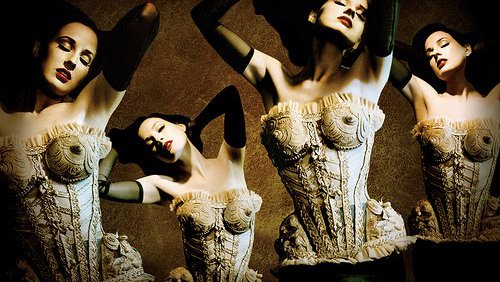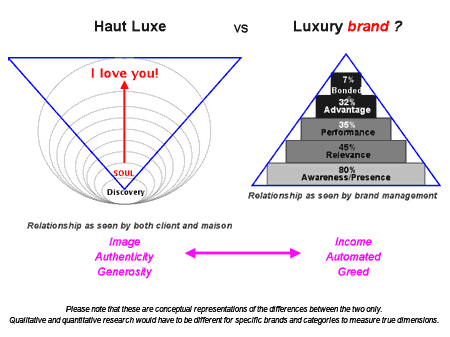
By approaching brand building like the stages of a love story, Philippe Mihailovich argues in his forthcoming book that luxury branding is more about human relationships – passion, desire, love, and trust than the mass market theories often used by companies today. The tenth in his monthly series explores the need for a reassuring personal touch.
Dita Von Teese in a Mr. Pearl corset
In the tenth of his monthly series Philippe Mihailovich argues in his forthcoming book that luxury branding is more about human relationships – passion, desire, love, and trust than the mass market theories often used by companies today. The tenth in his monthly series explores the need for a reassuring personal touch.
“There is little room left for the (small) luxury entrepreneur today. Financial luxury has taken over,” says Blanckaert (ex-Hermès). “This leads to a strange separation between a let’s-have-more luxury and the more discreet luxury of the families (luxury maisons). Luxury cannot survive such financial domination. As these family houses become shameless luxury product-making machines, they lose part of their soul, and the strength to fight to retain the expensive little details, buy the most precious skins, pay the workers a decent wage, and keep the quality impeccable. Paradoxically, it is only when houses free themselves from financial considerations that they create beauty. And maybe it is only by going beyond the logics of finance, that luxury can bloom and become truly profitable. When taken hostage, luxury loses its noblesse to join the lesser cohort of luxury marketing whose success is undeniable,” Blanckaert concludes (1).
Who’s hunting?
Traditionally branding speaks about targeting customers as hunters do whereas in luxury it has always been about attracting customers as sports fishermen do. The customers hunt the creation, for example a Mr. Pearl couture corset. At her wedding with Marilyn Manson, Dita von Teese wore one. For her performance in Paris, Kylie Minogue wore one. The stars come to him. “Kylie’s garment is said to have cost an astonishing £30,000,” wrote the Mail on Sunday’s Deborah Collcutt (2). South African-born Mark Pullin, known as Mr Pearl, has himself worn an 18in corset day and night for more than ten years. The master corsetier (there are only about five left in the whole world now, who possess that art) at first set up as a corset-maker to the stars in London in 1994 and moved to Paris in 2002, where he designs unique pieces for couture houses, painstakingly cutting, stitching and embroidering every one, often until his fingers bleed. Mr. Pearl gets discovered. He attracts celebrities and they pay for his unique pieces. He knows their intimate proportions and remains highly discreet. True Haut Luxe.
For big luxury brands, the personal touch of the creator is almost a myth. It is only on the small lines that we feel the real personal touch coming from the artisans and the creator. Yet even if the big houses continue to offer these atelier-made products, we are still aware of the fact that they are huge houses, so huge that they are perceived as factories with retail chains rather than discreet and intimate houses. In essence, industrialisation, globalisation and the introduction of modern branding techniques has turned the luxury model upside-down and led to the demise of the image of the great houses.
Courtship rituals
The diagram below illustrates the perceptual differences between the courtship that we have with Haut Luxe brands compared the one that we have with the big luxury brands. As stated in the earlier chapters, the Haute Luxe brand is discovered discreetly, perhaps sparked by a desirable creation made with passion, authentic savoire-faire and materials, and conceptualised by a visionary creator. His or her maison’s reputation builds slowly by word of mouth recommendations, magazine editorials and the like. A personal relationship is built with the creator or maison in the form that may be described as a personal relationship – including our love for the creation and respect for its creator and the artisans involved. The relationship would be considered reciprocal of appreciation, kindness, generosity, integrity and soul. It would be human and loyalty would be based on the continuation of such virtues.

The Luxury Brand triangle in the diagram, inspired by Millward Brown’s ‘Brand Dynamic Pyramid Model’ (3), illustrates that a strong brand may have a high level of awareness of say, 80 per cent of a market due to a certain level of exposure over time (e.g advertising), however the brand offer is only relevant to 45 per cent of this market. Only 35 per cent may try the brand’s product and only 32 per cent may find that the product has an advantage over those of competitors and 7 per cent are likely to become loyal to the brand. However, the 7 per cent loyal users are likely to represent 40 per cent of the brand’s income! It could be assumed that the loyal customers share the same feelings for their brands as reflected in the Haut Luxe pyramid.
Too popular?
The words ‘luxury’ and ‘brand’ tend to pull in opposite directions. The ‘Luxury Brand’ triangle above represents the big luxury brands that compete for exposure and business in the same way as mass brands have been doing for centuries. Their greatest differences lie in the fact that the high luxury comes from a heritage of creation i.e. aim to make one perfect shoe, or the perfect gourmet dish to win the village prize whereas the mass brands tend to be commercially driven and aim to win market share, as do today’s so-called ‘luxury brands’. The fame of the big luxury brands makes them celebrities in their own right, but their very celebrity leads to an over-exposure that alienates the more discerning buyer seeking rare and unusual creations and experiences. Clients defecting from the big brands are no longer doing so because the luxury brands have been offering cheaper products under the same name – as was the case during the licensing frenzy at the end of the 20th century. They are defecting due to over-marketing, over-exposure (over-selling, over-counterfeiting, over-retailing, over-globalising, over-hijacking) and general over-kill.
Along with Blanckaert, the Haute Luxe framework honours the individual rather than the mass. It cultivates warmth rather than efficiency, human connection and community rather than industrialisation and alienation, reverence for the spiritual, rather than skepticism. The Luxury Brand however is shown to build its relationships in customer’s minds using both luxury and mass techniques and it has proved to be one of the most powerful business models of our times. We will continue to witness many high luxury marques evolve into big luxury brands while the Haut Luxe purists remain true to their creations and their customers. Luxury Brands may even try to de-brand and downsize to feign a return to their humble but soulful Haut Luxe origins but it will not be an easy task. Why should they care about the few discerning customers who demand high service, high quality, everything made bespoke, by hand, with heart and soul, rare, one-off creations, made to perfection?
In the celebrity age, the big luxury brands are respected for their fame and fortune by the masses that want to belong to their universe and it is only when this majority become connoisseurs and defect that the big brands may suffer, but by then their owners are likely to be running the world’s largest Art Foundations and not Luxury Brand Groups.
Spoken for
“What I bring is my savoir faire, hours of work and passion, a sense of elegance inherited from my parents and my culture that can’t be taught, my originality – my studies in fine art left me a taste for objects that have a poetic meaning and a history, that reflect the personality of one creator, who invests all his soul into his creations,” says artist Olivia Clergue who grew up in the ancient city of Arles, in south of France, where the traditional costumes fascinated Van Gogh, Picasso (her godfather) as well as her photographer father’s friend, fashion designer, Christian Lacroix. Best known for her handmade bags embroidered with feathers, Olivia loves to walk in the beautiful landscapes of the Camargue, where she can pick up flamingo feathers directly from the sand. She actually created her first bag with such feathers and kept this incredible bag for her personal care – as flamingo feathers are protected they cannot be commercialized on bags.
Many other artists have ventured into making their own brands. Orlan makes her own wine and fragrances, Murakami makes his own collectable characters, and many have designed bags, fashion or other objects for established brands. The more we place a value on the personal touch, the more we begin to value the personal vision, concept and universe that comes with that personal touch. The more designers are flirting with artists, the more artists are flirting with design. No barriers are sacred anymore. Creativity has become democratised but a new hierarchy is emerging as a result. We are even finding aristocrats with elegant taste creating for an unsophisticated nouveau riche. With bespoke as the big buzzword in luxury, it begins to look ludicrous to imagine the crudest customers assuming the role of the great artists or designers in briefing highly trained craftspeople to make potentially ridiculous items.
That ‘someone’
As we become more connoisseur, we become more aware of creators who’s work we admire, and the more we admire and respect their high sense of aesthetic, the more we will trust what they will make for us. Haute Luxe is about collaborating with a visionary that you love and admire. They will understand you- your personality and your personal needs and will create the ‘to-die-for’ item or experience that you could never have imagined. That’s what bespoke should imply and not simply dictating your design to a craftsperson who will listen. The ultimate relationship is a one-to-one personal relationship where there is no master or servant. It’s a matter of producing something out of the fusion of your relationship that you will both love forever. You are giving birth to a creation of your shared dreams. Industry could not be further away from this ideal.
The more the personal touch and passion of a creator is involved in the product or experience that they are producing, the closer they are to touching us too. The future segments in the customers’ minds will not be that of Haut Luxe or Luxury Brand. Instead it will simply be about ‘True or Fake’. How true are you? How true is your brand? It may be time to re-examine your brand’s story to add some new truths and some additional authenticity including that personal touch with a heart and soul that may no longer be there. Luxury must feel like a ‘someone’. Ideally it is a ‘someone‘- someone that we can love, trust and respect
(1) Blanckaert, C, “Luxe”, Le Cherche Midi (2007)
(2) A fat chance Kylie! Mail on Sunday (3 April 2005)
(3) Franzen,G, Bouwman, M, “The Mental World of Brands: Mind, Memory and Brand Success”, NTC Publications (2001)









